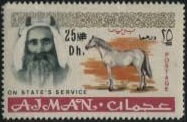Stamp: Sheikh Rashid and Arab Horse (Ajman 1967)
Sheikh Rashid and Arab Horse (Ajman 1967)
19 January (Ajman ) within release Native fauna goes into circulation Stamp Sheikh Rashid and Arab Horse face value 25 United Arab Emirates dirham
| Stamp Sheikh Rashid and Arab Horse in catalogues | |
|---|---|
| Michel: | Mi: AJ D10A |
| Colnect codes: | Col: AJ 1967.01.19-16 |
Stamp is horizontal format.
Also in the issue Native fauna:
- Stamp - Sheik Rashid and Dromedary (Camelus dromedarius) face value 50;
- Stamp - Sheik Rashid and Dromedary (Camelus dromedarius) face value 50;
- Stamp - Sheik Rashid and Queen Angelfish (Holacanthus ciliaris) face value 75;
- Stamp - Sheik Rashid and Queen Angelfish (Holacanthus ciliaris) face value 75;
- Stamp - Sheik Rashid and Royal Angelfish (Pygoplites diacanthus) face value 40;
- Stamp - Sheik Rashid and Royal Angelfish (Pygoplites diacanthus) face value 40;
- Stamp - Sheikh Rashid and Arab Horse face value 25;
- Stamp - Sheikh Rashid and Arab Horse face value 25;
- Stamp - Sheikh Rashid and Jewell Fish face value 75;
- Stamp - Sheikh Rashid and Jewell Fish face value 75;
- Stamp - Shaikh Rashid and Lanner Falcon (Falco biarmicus) face value 5;
- Stamp - Shaikh Rashid and Lanner Falcon (Falco biarmicus) face value 5;
- Stamp - Sheik Rashid and Spur-thighed Tortoise (Testudo graeca) face value 1;
- Stamp - Sheik Rashid and Spur-thighed Tortoise (Testudo graeca) face value 1;
- Stamp - Sheik Rashid and White Stork (Ciconia ciconia) face value 2;
- Stamp - Sheik Rashid and White Stork (Ciconia ciconia) face value 2;
- Stamp - Sheik Rashid, White-eyed Gull (Ichthyaetus leucophthalmus) face value 3;
- Stamp - Sheik Rashid, White-eyed Gull (Ichthyaetus leucophthalmus) face value 3;
Stamp Sheikh Rashid and Arab Horse it reflects the thematic directions:
Animals are multicellular, eukaryotic organisms of the kingdom Animalia (also called Metazoa). All animals are motile, meaning they can move spontaneously and independently, at some point in their lives. Their body plan eventually becomes fixed as they develop, although some undergo a process of metamorphosis later on in their lives. All animals are heterotrophs: they must ingest other organisms or their products for sustenance.
A head of state (or chief of state) is the public persona that officially represents the national unity and legitimacy of a sovereign state. In some countries, the head of state is a ceremonial figurehead with limited or no executive power, while in others, the head of state is also the head of government. In countries with parliamentary governments, the head of state is typically a ceremonial figurehead that does not actually guide day-to-day government activities and may not be empowered to exercise any kind of secular political authority (e.g., Queen Elizabeth II as Head of the Commonwealth). In countries where the head of state is also the head of government, the president serves as both a public figurehead and the actual highest ranking political leader who oversees the executive branch (e.g., the President of the United States).
The horse (Equus ferus caballus) is one of two extant subspecies of Equus ferus. It is an odd-toed ungulate mammal belonging to the taxonomic family Equidae. The horse has evolved over the past 45 to 55 million years from a small multi-toed creature, Eohippus, into the large, single-toed animal of today. Humans began to domesticate horses around 4000 BC, and their domestication is believed to have been widespread by 3000 BC. Horses in the subspecies caballus are domesticated, although some domesticated populations live in the wild as feral horses. These feral populations are not true wild horses, as this term is used to describe horses that have never been domesticated, such as the endangered Przewalski's horse, a separate subspecies, and the only remaining true wild horse. There is an extensive, specialized vocabulary used to describe equine-related concepts, covering everything from anatomy to life stages, size, colors, markings, breeds, locomotion, and behavior.



